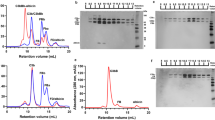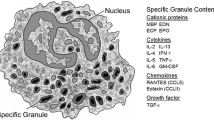Abstract
Anopheline mosquitoes play an essential role in malaria transmission. The mosquito salivates copiously when probing for the location of a blood vessel. We found that the saliva of anopheline mosquitoes has chemotactic activity for naive eosinophils or neutrophils. The major eosinophil chemotactic component in saliva was shown to be one of the chitinase family proteins. A similar chitinase family protein was found also in the midgut of the anopheline mosquito. Production of antibodies to the chitinase family protein was generally observed in the sera of residents of a malaria endemic area. Both Plasmodium falciparum-infected and uninfected individuals had antibodies to chitinases. These results suggest that the chitinase family protein in mosquito saliva contributes to eliciting an inflammatory response of eosinophils in the host skin followed by antibody production in the host.





Similar content being viewed by others
References
Bhatnagar RK, Arora N, Sachidanand S, Shahabuddin M, Keister D, Chauhan VS (2003) Synthetic propeptide inhibits mosquito midgut chitinase and blocks sporogonic development of malaria parasite. Biochem Biophys Res Commun 304:783–787
Breman JG, Alilio MS, Mills A (2004) Conquering the intolerable burden of malaria: what’s new, what’s needed: a summary. Am J Trop Med Hyg 71(2 Suppl):1–15
Brummer-Korvenkontio H, Palosuo T, Francois G, Reunala T (1997) Characterization of Aedes communis, Aedes aegypti and Anopheles stephensi mosquito saliva antigens by immunoblotting. Int Arch Allergy Immunol 112:169–174
Chang NC, Hung SI, Hwa KY, Kato I, Chen JE, Liu CH, Chang AC (2001) A macrophage protein, Ym1, transiently expressed during inflammation is a novel mammalian lectin. J Biol Chem 276:17497–17506
Griffiths RB, Gordon RM (1952) An apparatus which enables the process of feeding by mosquitoes to be observed in the tissues of a live rodent; together with an account of the ejection of saliva and its significance in Malaria. Ann Trop Med Parasitol 46:311–319
Hakala BE, White C, Recklies AD (1993) Human cartilage gp-39, a major secretory product of articular chondrocytes and synovial cells, is a mammalian member of a chitinase protein family. J Biol Chem 268:25803–25810
Hung SI, Chang AC, Kato I, Chang NC. (2002) Transient expression of Ym1, a heparin-binding lectin, during developmental hematopoiesis and inflammation. J Leukoc Biol 72:72–82
Kaslow DC (1997) Transmission-blocking vaccines: uses and current status of development. Int J Parasitol 27:183–189
Laemmli UK (1970) Cleavage of structural proteins during the assembly of the head of bacteriophage T4. Nature (London) 227:680–685
Litt M (1963) Studies in experimental eosinophilia. V. Eosinophils in lymph nodes of guinea pigs following primary antigenic stimulation. Am J Pathol 42:529–549
Owhashi M, Arita H, Hayai N (2000) Identification of a novel eosinophil chemotactic cytokine (ECF-L) as a chitinase family protein. J Biol Chem 275:1279–1286
Owhashi M, Harada M, Suguri S, Ohmae H, Ishii A (2001) The role of saliva of Anopheles stephensi in inflammatory response: identification of a high molecular weight neutrophil chemotactic factor. Parasitol Res 87:376–382
Reese TA, Liang HE, Tager AM, Luster AD, Van Rooijen N, Voehringer D, Locksley RM (2007) Chitin induces accumulation in tissue of innate immune cells associated with allergy. Nature 447:92–96
Remoue F, Cisse B, Ba F, Sokhna C, Herve JP, Boulanger D, Simondon F (2006) Evaluation of the antibody response to Anopheles salivary antigens as a potential marker of risk of malaria. Trans R Soc Trop Med Hyg 100:363–370
Reunala T, Lappalainen P, Brummer-Korvenkontio H, Coulie P, Palosuo T (1991) Cutaneous reactivity to mosquito bites: effect of cetirizine and development of anti-mosquito antibodies. Clin Exp Allergy 21:617–622
Ribeiro JM, Rossignol PA, Spielman A (1984) Role of mosquito saliva in blood vessel location. J Exp Biol 108:1–7
Rossignol PA, Lueders AM (1986) Bacteriolytic factor in the salivary glands of Aedes aegypti. Comp Biochem Physiol (B) 83:819–822
Shen Z, Jacobs-Lorena M (1997) Characterization of a novel gut-specific chitinase gene from the human malaria vector Anopheles gambiae. J Biol Chem 272:28895–28900
Shi L, Paskewitz SM (2004) Identification and molecular characterization of two immune-responsive chitinase family proteins from Anopheles gambiae. Insect Mol Biol 13:387–398
Stark KR, James AA (1996) The salivary glands of disease vectors. In: Beaty BJ, Marquardt WC (eds) The biology of disease vectors. University Press of Colorado, Denver, pp 333–348
Tanaka H, Matsuda H, Blas BL, Nosenas JS, Hayashi M, Iuchi M, Nakao M, Santos AT Jr (1983) Evaluation of micro-ELISA for schistosomiasis japonica using crude egg antigen. Jpn J Exp Med 53:147–154
Towbin H, Gordon J (1984) Immunoblotting and dot immunobinding—current status and outlook. J Immunol Methods 72:313–340
Waidhet-Kouadio P, Yuda M, Ando K, Chinzei Y (1998) Purification and characterization of a thrombin inhibitor from the salivary glands of a malarial vector mosquito, Anopheles stephensi. Biochim Biophys Acta 1381:227–233
Acknowledgments
We wish to thank Drs. H. Matsuoka (Jichi Medical University) and H. Takagi (Nagasaki University) for their helpful advice and discussions. This work was supported in part by a Grant-in-Aid for Scientific Research (1759031, 17406008) from the Japan Society for the Promotion of Science; a Grant for International Health Cooperation Research (16C-1, 19C-1) from the Ministry of Health, Labor and Welfare of Japan. The experiments comply with the current laws of the country in which the experiments were performed.
Author information
Authors and Affiliations
Corresponding author
Rights and permissions
About this article
Cite this article
Owhashi, M., Harada, M., Suguri, S. et al. Identification of an eosinophil chemotactic factor from anopheline mosquitoes as a chitinase family protein. Parasitol Res 102, 357–363 (2008). https://doi.org/10.1007/s00436-007-0769-3
Received:
Accepted:
Published:
Issue Date:
DOI: https://doi.org/10.1007/s00436-007-0769-3




